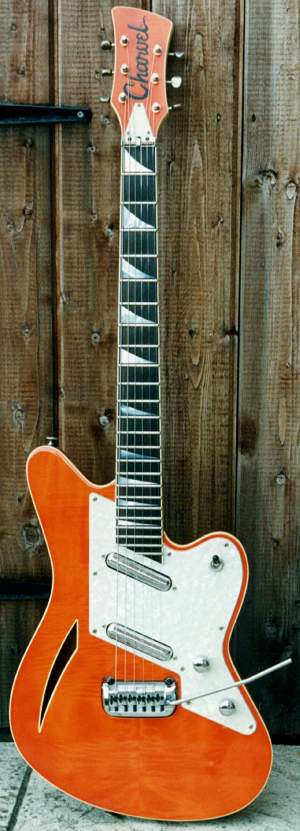
It was perhaps inevitable that the high-tech music production values of the 1980's would give way to a more organic, "retro" style in the 1990's, as guitar-based groups and songwriters gradually returned to replace synthesizers and sequenced drums in the music fashion of the day. Guitar manufacturers like Fender, Rickenbacker and Gretsch were quick to recognise the trend and began to build relatively faithful reproductions of their 'fifties and 'sixties classics. Uncharacteristically, the Japanese Charvel company, best known for its droopy-headstock heavy metal axes like the Predator, Spectrum and Classic series, put together this weird hybrid at the request of a client. The unlikely result proved so successful that they went into production with it, offering a number of vintage colour options like turquoise, Fireglo sunburst, Charcoal Frost and my favourite, this Gretsch-style translucent orange.
It's the bizarre mixture of parts and appointments that make this guitar a unique playing experience. The bound maple bolt-on neck, with its spliced, maple-veneered headstock and pearl snow-drift inlays, comes with 23-and-a-half jumbo speed-metal frets and an adjustable brass roller nut. The pick-ups are similar to Danelectro's lipstick-tubes, and though not very powerful they deliver a lovely shimmering twang, particularly when the strings are new. Mounted on a tacky-looking pearl-effect plastic plate, they're controlled by a selector switch, and volume and tone controls that have Telecaster-style knurled knobs. The tone control is a spring-loaded Omni-pot that throws the pick-ups out of phase when both are active, producing an odd and frankly useless twanky sound.
The Gotoh tremolo assembly works quite well, to a point; basically Stratocaster-styled, its leading edge pivots on two adjustable studs, and comes with six individually-adjustable string saddles. Unfortunately, it was supplied with only three return springs = a tuning disaster in waiting. Should anybody from Gotoh be reading this, take note; three springs - don't work. Five springs - work. Leo F. got it right. Just shorten the springs by half an inch. This way, it will be possible to lift the arm through a whole step without the springs popping out of the claw in the back, and it will return to pitch.
The bound top edge of the guitar sets off two gorgeous book-matched pieces of flame maple veneer, with a Rickenbacker-style slash sound-hole exposing an acoustic chamber on the left. It's a shame that the hardware is Japanese, since the tuners, jack-socket and switch are all a tad flimsy and not likely to stay the course.
However, this instrument is loaded with character, and sounds and plays great. It always draws comments from punters on the few occasions I've used it in public, and is an invaluable addition to my collection.
Recording debut: I loaned this guitar to Martin Phillips of the Chills,
for his Sunburnt sessions, summer 1995, so I imagine it's on that
album somewhere. He went out and bought one for himself straight after!
Features on: You Dinosaur Thing; The Last Thing (h, 1996);
Fruit Nut (XTC, 1998)
dozens of home recordings, and a rockin' early version of Playground (XTC, 1998)
which sadly you will not now have the opportunity of hearing.